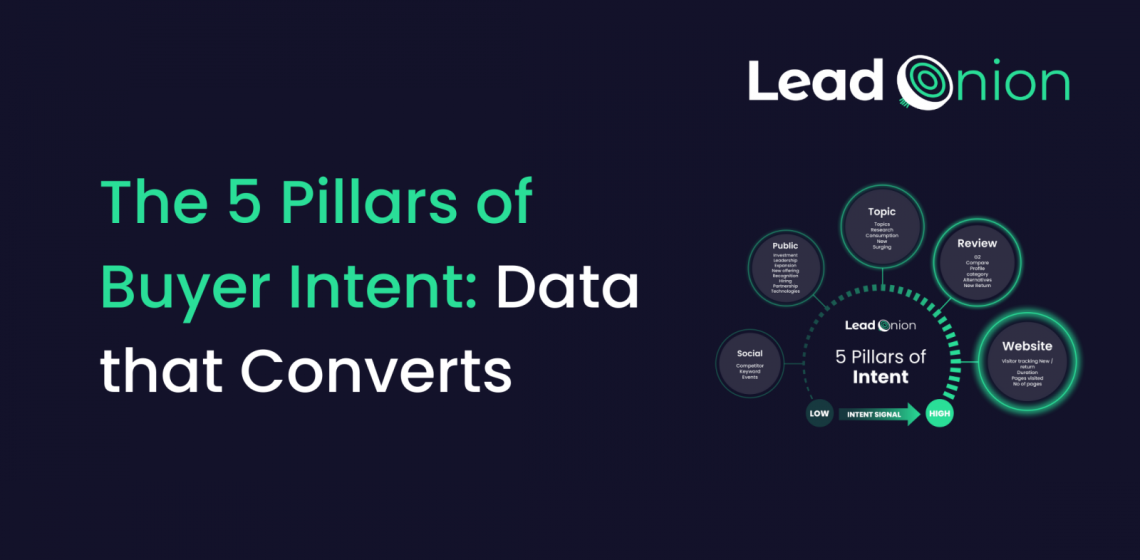If you want to grow your business, you need to know who is in your target market. Identifying buyers that fit your ideal customer profile is essential for targeted prospecting and successful conversion.
From low, all the way to high-intensity signals, buyer intent is the best way to gauge your prospect’s interest in your business.
The 5 Pillars Of Buyer Intent
There are 5 pillars of buyer intent that indicate the prospect's level of intent to purchase. Ranging from low to high intensity, the pillars of intent help you to qualify and prioritize your leads to make sure you convert them quickly and effectively.

Social Intent
Social Intent tools can help you mine social media sites for interactions that may indicate buying intent.
The more information you have on your prospective customers, the better you can target them at the right time of their buyer journey.
Monitoring their engagement within your industry is a clear sign of interest that you should consider when prospecting. Whether it’s a liked post, comments left on industry forums, or shared content, if your prospects engage with your competitors online, you need to know about it.
The same is true for tracking the keywords that are common in your industry. At the beginning of their buyer journey, your prospects will be conducting in-depth research into your product using these keywords.
One of the best places to find prospective buyers are trade shows, conferences, and industry events. By monitoring your interactions with these events, such as using the official hashtag, online check-ins, or mentions of the event on social platforms, you can identify businesses that are actively involved in your industry and potentially looking for your solution.
It may sound counterintuitive, but monitoring when your prospects adopt new technologies can present the opportunity for your sales team to reach out with competitive offers, or complimentary services.
Public Intent
Research suggests that 43% of sales representatives feel they lack information before reaching out to prospects.
Any movement in the decision-making process is worth monitoring when looking for prospective clients. Hiring new talent, securing new funding rounds, or announcing expansions, mergers, and acquisitions not only signal access to funds but can indicate the need for new products or services.
By monitoring public intent signals, you can get ahead of your competition and let your sales team reach out at this crucial stage. More than that, use the information you have collected and make your outreach personal, by congratulating them on their recent success.
Topic Intent
Your buyers do not sit around waiting for sales teams to offer them the perfect deal. Modern B2B buyers are actively researching their desired products and bounce around between several Google searches, social channels, whitepaper materials, and emails before making a purchasing decision.
Research by marketingcharts.com confirmed, that B2B buyers are more open to engaging with vendors early on, with Aberdeen reporting that almost half (48%) of buyers say they are most open to challenges to their thinking at the beginning stages of their research.
Knowing exactly when your prospect starts looking for you, means you can reach out to them at the time they need you. Depending on their queries, you can decide whether you need to supply them with more information about your product or service, help them with a query they might have, or convert right there and then.
Review
For any business, user and authentic peer reviews are essential. Leading B2B review platform, G2, gives you company-level information on users who are looking for your product or similar solutions in your industry.
Your target audience looking at your brand and perusing your peer reviews indicate high levels of buyer intent, that you need to be aware of. Lead Onion’s integration with the review site means you can monitor your prospect’s research into any of your competitors or identify prospects that are interested in your industry and operationalize company-level intent data.
Website Intent
As soon as your prospects start looking at your website, you can be assured that they are interested in your solution.
The highest level of intent, activity on your website, and the sections your prospects are visiting will inform you who your high-value leads are and what marketing and sales communications they require to convert them from prospects to buyers.
So how can you track all these intent signals?
The answer is Lead Onion the market-leading Intent-driven sales enablement platform.
With over 50 billion touchpoints of buyer intent signals and access to 400M B2B profiles Lead Onion offers the best source of buyer intent intelligence for data-driven sales strategies.
Maximize your sales teams’ productivity with automated workflows integrated into one platform. With Lead Onion, your buyer intent intelligence automatically feeds into your automated qualifying process to deliver the hottest leads, ready to be added to your sales funnel.
With the combination of the ai-powered search tool, the automated qualifying process, and built-in cadences, you can optimize your B2B customer journeys and identify the right time to make that initial call, and use customer insights to connect to your leads on a personal level.
Leverage intent data in every conversation to smash your sales goals
✅ Prospect at scale using complaint B2B Data.
✅ Identify buyers showing intent through 17 intent sources.
✅ Automatically prioritize and qualify prospects.
✅ Reach more decision-makers through automated triggers.
Download our guide to Developing a Data Driven Sales Strategy and find out how to get the most out of your data.


